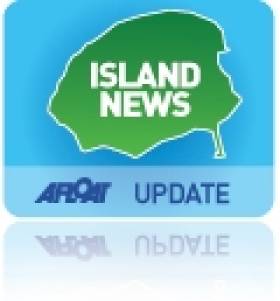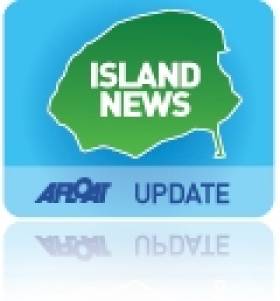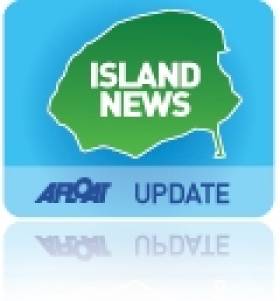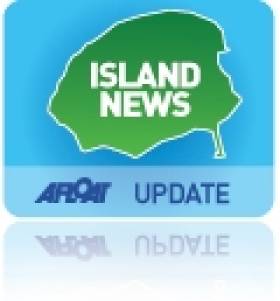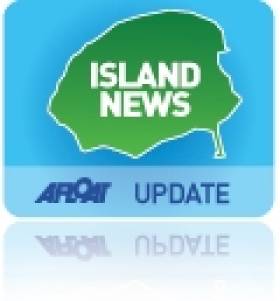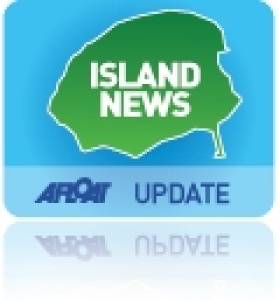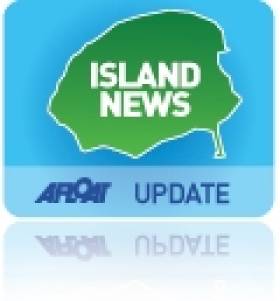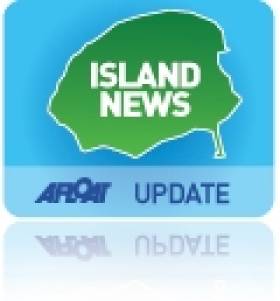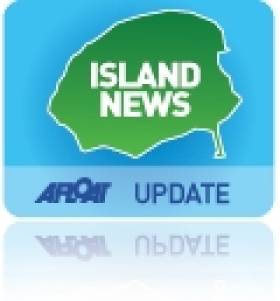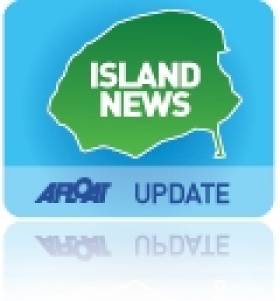Displaying items by tag: Island News
Achill Islanders Not So 'Keem' On Viewing Platform Plans
#IslandNews - A glass-floored viewing platform jutting out over the Atlantic Ocean on Achill Island has got officials excited about its potential to attract tourism.
But locals are concerned that the project could mar the area's special views with an eyesore.
As the Mayo News reported last month, funding has been secured to develop the so-called 'Signature Discovery Point' at Keem Beach on Ireland's largest coastal island.
Keem Beach is one of 35 locations along the Wild Atlantic Way in Co Mayo that will share in the €257 million funding pot.
And the ambitious plans for the area – that also features as part of the new Galway-Mayo Blueway – include a viewing platform over the waves and rocky shore near the old coastguard station, along the lines of the Grand Canyon Skywalk.
But the reaction among the Achill community has been mixed, with support for the initiative by development company Comhlacht Forbartha Áitiúil Acla tempered by comments from local sculptor Ronan Halpin, who expressed concerns over the "visual intrusion" and "sustainability" of such a unique engineering project.
“Keem Bay is one the most beautiful and unspoilt places in our country. Its isolation and seclusion are a major part of its inherent charm," he added. "The proposal to build a glass walkway at the top of Moiteóg would seem to fly in the face of all this natural beauty and majesty."
The Mayo News has much more on the story HERE.
Mayo Island Residents Face Christmas Without Medical Cover
#IslandNews - Some 58 people on an island off west Mayo face their first Christmas in decades without medical cover, as The Irish Times reports.
The residents of Inishturk have been left in the lurch as the HSE West has not filled the vacant nursing post on the island, following the retirement of the community's previous nurse after 30 years in September.
Since then the island has only had two days of medical cover, according to local community worker Mary Heanue – who blamed the wider issue of cutbacks in services to Ireland's offshore island communities.
And last night Clifden RNLI was tasked to provide "urgent and immediate" medical attention to an elderly resident on the island, some 14km off the Mayo coast.
The Irish Times has more on the story HERE.
Offshore Islands Fear Termination Of Core Community Funding
#IslandNews - Nine offshore island communities are set to hold a press conference this coming Wednesday (19 November) over Government plans to terminate core funding for community development.
“The withdrawal of this funding will mean the collapse of a wide range of programmes, activities and initiatives on the islands," according to John Orpan, vice-chair of the West Cork Island Community Council.
That group is one of a number represents the nine non-Gaeltacht islands that would be impacted by the proposal, including Inishbofin, Inishturk, Clare Island, Bere Island, Sherkin Island, Dursey Island, Whiddy Island, Long Island and Heir Island.
Currently, five Island Community Development Companies covering these West Coast islands are managed by voluntary committees to provide services for their communities, funded with some €600,000 annually.
And locals fear that the termination of this core funding "will have disastrous short, medium and long-term effects" on the islands, which "are of added importance as a symbol of and link to the promotion of the Wild Atlantic Way" tourism initiative.
"The inhabited islands off the Irish coast are a unique reservoir of arts, culture, identity and heritage," said Michelle O'Mahoney of Clare Island. "They are home to living, breathing communities, and the Government has a duty to ensure that these communities remain viable and vibrant.”
Island representatives will air their position to the press and the Oireachtas at Buswells Hotel on Wednesday 19 November at 4pm.
Skellig Michael Set For Film Shoot - Could It Be Star Wars?
#IslandNews - Could Star Wars be coming to the Skelligs? According to some reports, the 'Force' is with the Co Kerry islands - specifically Skellig Michael.
The Daily Edge has confirmed with the Office of Public Works that a film production is indeed scheduled to take place on the island, which houses one of Ireland's earliest monastic settlements.
But as yet it's still hearsay as to whether the filming will be for JJ Abrams' long-awaited seventh instalment of the Star Wars saga.
#ScatteryIsland – Brian Ború's 10th century invasion of the monastic settlement of Scattery Island and the subsequent killing of the Viking King of Limerick and his two sons will be recreated in County Clare later this month.
The Scattery Island Festival on July 26th-27th also features guided walks, lectures, music and song, and marine activities celebrating the island's association with St. Senan, the Vikings, Brian Ború, the Spanish Armada and later as a defence outpost for the British.
Uninhabited since 1979, Scattery Island - also known as Inish Cathaigh - is located approximately one mile from Kilrush in the Shannon Estuary and is home to a monastery founded in the early 6th century by St. Senan. The island features the ruins of six churches and one of the highest Round Towers in Ireland at 120 ft. high.
The re-enactment of the raid on the island by Brian Ború and his the Dál Cais army is the main event of the upcoming Scattery Island Festival, which is part of the national Brian Boru Programme and coincides with the millennial anniversary of Ború's death at the Battle of Clontarf in 1014.
Academics and historians have for many years argued whether or not Ború broke sanctuary by killing on church land as he sought revenge for the murder by King Ivar of his older brother and King of Munster, Mahon. Most agree however, that the incident consolidated Brian's position as Mahon's successor and helped him in his quest to become High King of Ireland.
Dr. Catherine Swift, Course Director, Irish Studies Mary Immaculate College explained: "The Annals of Inisfallen state that Ímar, king of the foreigners, and his two sons, were killed on Inis Cathaig by Brian, son of Cennétig in 977AD. In an account given in the Annals of Loch Cé meanwhile, Brian sees a vision of St Senán condemning him for breaking sanctuary by killing on church land which is taken to be this incident. Whatever one's opinion is of the manner in which the Norse King was slain, it is clear that his death paved the way for Brian to enjoy unchallenged rule over his home Province of Munster."
Rita McCarthy of the Scattery Island Heritage & Tourism Group said the re-enactment will be the focal point of this year's Festival, the theme of which is 'Invade Scattery'.
Also taking place during the course of the weekend will be a Ceremony of Remembrance for past inhabitants of the island, a Curragh Race, Music and Song with Inis Cathaigh Comhaltas, guided tours of the island by the OPW, talks on Scattery Island's environment and history, a Treasure Hunt for children, and tours to the Napoleonic Battery.
Ms. McCarhy continued: "We are inviting former island inhabitants and anyone with a connection with Scattery or indeed, its rich history to join us on the weekend of July 26-27th. Last year's inaugural festival, held as part of the Gathering Ireland initiative, proved to be a huge success with more than 5,000 people travelling to the island. This has helped to raise the profile of what has for many years been one of Ireland's least known monastic settlements."
The Scattery Island Festival on July 26th-27th is part-funded under the Community Tourism Diaspora Fund, operated locally by Clare County Council, IPB and Failte Ireland. For more visit www.brianborumillennium.ie, see Facebook (Scattery Island/Kilrush Gathering), or contact Rita McCarthy of the Scattery Island Heritage and Tourism Group on 087-9731162 / [email protected].
#DalkeyIslandFerry – The Dalkey Island passenger ferry boat service from Coliemore Harbour, Co. Dublin, was finally launched into service and coincidentally on the opening of the 5th Dalkey Book Festival last Thursday, writes Jehan Ashmore.
There had been no ferry service for the last three years which had been a concern of the local community who have campaigned for its restoration since the issue of 'health and safety' was raised by Dun Laoghaire Rathdown County Council on the state of Coliemore Harbour and also those on the island.
Now that the commercial passenger-ferry boat which is licensed to take 5 persons, locals and visitors can look forward to taking the 4 minute hop across Dalkey Sound.
The service is operated by Ken Cunningham, whose family for many generations have been closely involved with the harbour and also of the local East coast skiff rowing club.
During last weekend the scene at Coliemore Harbour was under a 'blocking' high weather system with blue seas and equally skies. Tourists lined the plaza overlooking the harbour and also admiring the view was a festival guest, author Salman Rushdie, of Satanic Verses fame who was there for an interview and photocall.
Against this scenic publicity backdrop the seascape also provided the setting for a local artist's group and where a former wife of Rushdie, Padma Lakshmi took a keen interest with the painting students.
As previously reported on Afloat.ie, a new slipway and quayside structure was completed on Dalkey Island and was officially launched earlier this month by An Cathaoirleach, of Dun Laoghaire-Rathdown County Council.
The opening of the upgraded island harbour facility costing €350,000 was a turning point of the PART 8 Programme in addition to works amounting to €63,500 also carried out at Coliemore Harbour, where issues concerning boating access and safety were also met. Though there were some delays to these works before the ferry eventually could start and that of a permit issued from DLRCC.
A campaign led by the Coliemore Harbour Action Committee pressed local councillors and that of DLRCC to reinstate that the 'traditional' ferry boat would remain running from the harbour as fears had been expressed of an alternative replacement service from Dun Loaghaire Harbour.
The Dalkey Island slipway upgrade incorporates a widened channel and dredging creating easier and safer access for berthing and a navigation marker post is sited at the end of the slipway.
To accommodate the tidal range, at the approach of the new structure is the 'stepped'-slipway section which runs into an upper quayside featuring a ladder and life-ring pole.
From here new steps lead to the existing footpath to the Martello Tower, the main man-made feature on the island which is designated a public park.
The island on the doorstep to Dublin and its tourism potential and the role of public engagement forms one of the main topics of the Dalkey Islands Conservation Plan: 2014-2024 which was launched by DLRCC earlier this month.
The other principle topics of the plan to recognise and manage island issues are: history & archaeology, natural heritage, geological heritage, archaeological and built heritage.
New Slipway on Dalkey Island Officially Opened
#DalkeyIslandSlipOpens – Dalkey Island's newly constructed slipway harbour was officially opened today by An Cathaoirleach of Dún Laoghaire-Rathdown County Council, Cllr Carrie Smyth, writes Jehan Ashmore.
Speaking at the launch at Coliemore Harbour, An Cathaoirleach said: "I am delighted to be able to officially open the new slipway on Dalkey Island in what are my last few days as Cathaoirleach. Dalkey Island is a truly beautiful and important part of our county and I congratulate all of those who contributed to this project."
As previously reported on Afloat.ie, the works of the slipway landing stage were carried out by Richard Nolan Civic Engineering and took almost a month to complete.
The upgrade which cost €350,000 was part of a PART 8 Programme which was implemented following a study undertaken in January 2010 that identified that the existing slipway on the island had fallen into a state of disrepair, restricting access at low tides.
According to Declan Nolan of the contractors, some of the work days involved extended 18 hours due to access delays caused by the vagaries of the sea.
During the main construction stage, this necessitated use of a self-propelled pontoon barge, the Kesmit that transported heavy plant machinery weighing more than 20 tonnes and building supplies that were loaded at Dun Laoghaire Harbour.
The new slipway is stepped at various heights for the tidal range and is overall higher than that of the previous structure. A widened channel and dredging has created easier and safer access for boats to berth.
Most importantly, the public can once again safely visit Dalkey Island which is designated as one of 16 parks within Dun Laoghaire-Rathdown County Council.
Dalkey Island's strategic location between Dublin and Co. Wicklow provides an experience that is a unique place with significant seascapes of both Dublin and Killiney bays. In addition the 20-acre island's importance is varied in terms of ecological, archaeological, architectural and cultural heritage.
As for tourism potential, a new combined visitor ticket to the Dalkey Castle & Heritage Centre and passage to the island by a licensed commercial ferryboat will be made available for the first time.
There has not been a ferryboat service for three years, though the reinstatement of such service is expected to return within the next fortnight.The delay is due to the final stages of the new slipway where safety features to improve boarding and disembarkation is currently underway.
Equally similar works at Coliemore Harbour are also in progress to address and improve safer and easier access for boarding and disembarkation.
It is understood that Tim Carey, Heritage Officer of the DLRCoCo who launched the Dalkey Islands Conservation Plan: 2014-2024 along with Cllr Carrie Smyth earlier this week, has already granted a permit for the ferryboat which too has been certified with a license from the Department of Transport.
Only when such safety feature works are completed on both the island and the mainland that the commercial ferryboat service will resume. The boat is licensed to take five passengers on each of the 4-minute hop crossings to the island.
Heir Island Regatta For Both Novice & Avid Sailors
#heirisland – Now in its sixth year the Heir Island Regatta in West Cork is a fun day out for both the avid and more novice sailor. Run by volunteers all the proceeds go to the RNLI Lifeboats.
Bull Island Action Group Announces New Clean Up Plans
The Bull Island Action Group (BIAG) has announced a renewed commitment by the Dublin Port Company to the environmental management of the Dublin Bay's Bull Island.
The Dublin Port Company has pledged to support the work of the BIAG in two key ways:-
1) By undertaking specialist cleaning contractors to remove litter and debris from the rock armour on the Dublin Port side of the Bull Wall twice yearly. This is a really significant investment of resources and labour and will add greatly to the visual amenity of the thousands of walkers, joggers, sea swimmers, cyclists and sightseers who exercise and take fresh air all year round on the Bull Wall. The first major cleanup of the rock armour in recent years has just been completed to coincide with Clean Coasts Week 2013.
2) By supplying the BIAG with cleaning equipment such as litter pickers, bin-bag hoops and other janitorial supplies as the need arises.
The Dublin Port Company joins the other stakeholders in the environmental management of the amenity –
· Dublin City Council: supplies the BIAG with equipment and provides a tractor and trailer to haul away the rubbish collected by our volunteers each month.
· Clean Coasts Ireland (An Taisce): provides the BIAG with support, public liability insurance, publicity and equipment.
· Volunteer Ireland via www.volunteerdublincitynorth.ie : provides opportunities to reach out to new and potential volunteers.
Plans for New West Cork Island Ferry Service
#IslandFerry – West Cork island ferry operator Cailin Óir Ferry Service which runs the Baltimore-Cape Clear route plans to operate a new service also from the island to Schull.
The development follows a decision to no longer operate from this year the service between Schull and Cape Clear which was run for many years by the Molloy Family using the Karycraft ferry.
Cailín Óir Ferry Service will operate the new service across Roaringwater Bay using relief vessel Dún Aengus. The ferry schedule is to run two days a week in June and increases to five days between 1 July to 25 August.
For more on this story and from this region, visit: www.westcorkislands.com/?p=1154


























